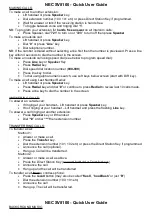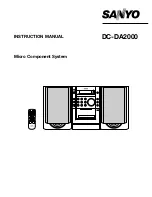
This is a publication by Conrad Electronic SE, Klaus-Conrad-Str. 1, D-92240 Hirschau (www.conrad.com).
All rights including translation reserved. Reproduction by any method, e.g. photocopy, microfilming, or the capture in
electronic data processing systems require the prior written approval by the editor. Reprinting, also in part, is prohibited.
This publication represent the technical status at the time of printing.
© Copyright 2019 by Conrad Electronic SE.
1680336_V2_0119_02_VTP_m_en
Choice of location, range
The product provides wireless transmission of an DVI-compatible video signal. 5 GHz techno-
logy is used for the transmission.
Do not position the devices so that objects/devices/walls/glass or people are in between the
transmitting and the receiving module, which would reduce the range greatly.
Due to the different influences on the radio transmission, a specific range cannot be guaran-
teed. Try to change orientation and location of the transmitter and receiver modules. Reduce
the distance between the two devices; use for example a longer (and high-quality) DVI cable.
Protect the surfaces of valuable furniture by using a suitable mat to prevent scratches, pressure
points or discolouration.
It is possible to fasten the transmitter and receiver modules securely at a suitable location.
Depending on the mounting location, use appropriate screws and, if necessary, dowels. Pay
attention when drilling and tightening the screws that no cables or pipes are damaged. Before
fastening the devices in place by screws, check first whether faultless video broadcasting is
possible.
Connection and start-up
Example:
First switch off all the devices that you wish to connect to the transmitter and receiver
modules.
• Connect the DVI input (5) of the transmitter module to the DVI output of a playback device
using the appropriate cable.
• Connect a monitor or projector to the DVI output (12) of the receiving module.
• Connect the round power sockets of the transmitter and receiver each to one of the two
power adapters included (the two adapters are identical constructed!).
• Finally, connect the power adapters to a mains socket.
• Switch on the devices connected to the transmitter/receiver modules.
• The LEDs at the front of the transmitter and the receiver module are indicating functions:
- Power LED (1, 8): The LED is on when the modules are connected to voltage/power.
- Data transmission LED (2, 9): The LED indicates whether video data is being transmitted
(LED flashes).
- Link LED (3, 10): The LED indicates whether the devices are radio-linked.
The devices connected to the transmitter/receiver modules must be switched on and
ready for operation, so that a connection can be established.
Troubleshooting
No image
• Switch all devices on and/or connect transmitter and receiver modules to mains voltage via
the AC adapter.
• While the transmitter and receiver modules are connected to the operating voltage press the
“RESET” buttons on both devices.
• Reduce the distance between the transmitter and receiver modules, change the location.
Do not position the devices so that objects/devices/walls/glass or people are in between the
transmitting and the receiving modules, which would reduce the range greatly.
• Do not place any devices onto the transmitter/receiver module; do not place them between
other devices. This greatly reduces the radio range.
• Use high-quality DVI cables. Try using a cable with an HDMI/DVI plug instead of using an
HDMI/DVI adapter.
• The DVI input/output supports digital signals (DVI-D) only.
• Select the proper input on the TV set/monitor.
• Disconnect the transmitter/receiver modules from the operating voltage for a few seconds.
• Check the settings of the devices connected to the transmitter/receiver modules such as
whether the TV can display the video signal received from the player. Test and connect the
player directly to the television/monitor.
Picture interferences, picture drop out
• Reduce the distance between the transmitter and receiver modules, change the location.
• Disconnect the transmitter/receiver modules from the operating voltage for a few seconds or
press “RESET” on both devices.
Range too low
• Keep distance to other devices that work with the same frequency range (for example, rou-
ters).
• Realign the antennas. Ideal is, if the two antennas are parallel to each other. However, if
the tips of the antennas are pointed at each other, then this will result in a very short range.
No sound
• The DVI connectors of the transmitter and receiver modules cannot transmit sound. This is
also the case when HDMI/DVI adapters are used.
Care and cleaning
Disconnect the product from the power supply before cleaning.
Never use abrasive cleaning agents, rubbing alcohol or other chemical solutions, since these
could damage the casing or even impair operation.
Use a dry, lint-free cloth to clean the product.
Declaration of conformity (DOC)
Conrad Electronic SE, Klaus-Conrad-Straße 1, D-92240 Hirschau hereby declares that this
product conforms to the 2014/53/EU directive.
Click on the following link to read the full text of the EU declaration of conformity:
www.conrad.com/downloads
Select a language by clicking on a flag symbol and enter the product order number
in the search box. You can then download the EU declaration of conformity in PDF
format.
Disposal
Electronic devices are recyclable materials and do not belong in the household was-
te. Dispose of an unserviceable product in accordance with the relevant statutory
regulations.
Technical data
a) Transmitter module (“TX”)
Operating voltage ......................... 5 V/DC
Transmission frequency................ 5180 - 5240 MHz
Transmission power...................... 10 dBm
Range ........................................... max. 200 m (at open-air line of sight between transmitter
and receiver modules)
Transmission protocol................... HDbitT
Resolution supported .................... 800 x 600, 1024 x 768, 1280 x 720, 1280 x 960,
1366 x 768, 1440 x 900, 1680 x 1050, 1920 x 1080,
each 60 Hz
DVI input ....................................... 1 (DVI-D, only digital signals)
Dimensions ................................... 195 x 33 x 101 mm (W x H x D)
Weight .......................................... approx. 573 g
b) Receiver module (“RX”)
Operating voltage ......................... 5 V/DC
DVI output ..................................... 1 (DVI-D, only digital signals)
Dimensions ................................... 195 x 32.5 x 101 mm (W x H x D)
Weight .......................................... approx. 574 g
c) AC adapters (2 pieces included in the delivery)
Operating voltage ......................... 100 - 240 V/AC, 50/60 Hz
Output ........................................... 5 V/DC, 3 A
d) General information
Operating conditions ..................... Temperature 0 °C to +60 °C, air humidity 10% to 95%
relative, noncondensing
Storage conditions ........................ Temperature -15 °C to +55 °C, air humidity 10% to 95%
relative, noncondensing


























